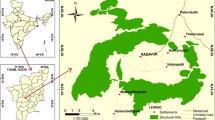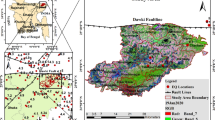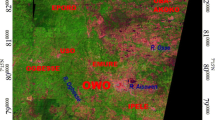Abstract
In the present study, an attempt has been made to delineate and characterize the different geomorphic units of Tundiya river catchment in a part of Lower Maharahstra Metamorphic Plateau, north-eastern part of Nagpur district, Maharashtra. The drainage, contour and delineated geological units have been overlaid on IRS-ID LISS III satellite imagery (bands 2,3 and 4) in EASI/PACE analysis system to delineate and characterize different geomorphological units and analysis of their processes based on the field observations. The study area is basically of metamorphic in origin with different geological formations and is influenced by the various fluvio-morphological processes. Based on the satellite data analysis, the distinct geomorphological units viz., table top summits, structural hills, subdued plateau, linear ridges, shallow, moderate and deeply buried foot slopes, shallow valley fills and deep valley fills have been delineated and characterized. The information generated from satellite data in the form of vector layers has been used in GIS to generate geological and geomorphological maps of the study area. The present study demonstrates that IRS-ID LISS-III data in conjunction with geology, drainage and contour parameters to enable detailed evaluation of different geomorphological units and analysis of their processes based on the field observations. The delineated geomorphological units can be utilized for evaluation and management of natural resources and geo-environment on sustainable basis at river catchment level.
Similar content being viewed by others
References
Cook, R.U. and Doornkamp. J.C. (1974). Geomorphology in Environmental Management: An Introduction, 413 p., Clarendon Press, Oxford.
Crofts, R.S. (1974). Detailed geomorphological mapping and land evaluation in highland Scotland, in Progress in Geomorphology, (Edited by E.H. Brown and R.S. Waters), pp. 231–249, Institute of British Geographers, Special Publ. 7.
Demek, J. (1972). Manual for Detailed Geomorphological Mapping, 320p., IGU Commission on Geomorphic Survey and Mapping, Academia, Prague.
Demek, J. (1982). Geomorphological mapping: progress and problems in Perspectives in Geomorphology, Vol. IIIÑ Applied Geomorphology, (Edited by H.S. Sharma), pp. 221–235, New Delhi.
Fairbridge, R.W. (1968). The Encyclopedia of Geomorphology, Encyclopedia of Earth Science Series, VIII, Dowden, Hutchinson & Ross, Inc. Stroudsburg, Pennsylvania. pp 388–403.
Geological Survey of India (GSI) (1978). Geological Quadrangle map of Topographical sheet 55 O (Nagpur): Madhya Pradesh — Maharashtra, Geological Society of India, India.
Krishnan, M.S. (1982). Geology of India and Burma, Edition (IV): 1–536.
Krishnamurthy, J. and Srinivas, G. (1996). Demarcation of geological and geomorphological features of parts of Dharwar Craton, Karnataka, using IRS LISS-II data, Int. J. Remote Sensing,17(16): 3271–3288.
Mukerjee, S. (1982). Remote sensing in geomorphological mapping, in Perspectives in Geomorphology, Vol. IIIÑ Applied Geomorphology (Edited by H.S. Sharma), pp. 271–277, New Delhi.
Panizza, M. (1978). Analysis and mapping of geomorphological processes in environmental management, Geoforum,9: 1–15.
PCI, (1997). SPANS, GIS Software, Ver. 7.0, PCI, Ontario, Canada.
PCI, (2000). EASI/PACE, Image analysis System Ver. 7.0., PCI, Ontario, Canada.
PCI, (2000). Geomorphology: Diversity in quantitative surface analysis, Progress in Physical Geography,24: 1–20.
Reddy Obi, G.P., Maji, A.K., Srinivas, C.V Thayalan, S and Velayutham, M. (2001). Landscape ecological planning in a basaltic terrain, central India using remote sensing and GIS techniques, J. Indian Soc. of Remote Sensing,29(1&2):3–16.
Strahler, A.N. (1964). Quantitative Geomorphology of basins and channel networks, Handbook of applied Hydrology (Ed. Ven Te Chow). Mcgraw Hill Book Company, New York.
Subramanyan, V. (1981). Geomorphology of the Deccan volcanic province in Deccan Volcanism and related basalt provinces in other parts of the world. Geological Survey of India, Memoir No. 3 (Subbarao, K.V. and Sukheswala, R.N. eds., pp. 101–116, GSI, Bangalore.
Wright, R.L. (1993). Principles in a geomorphological approach to land classification, Zeitschrit für Geomorphologie,16(4): 31–373, 1972.
Author information
Authors and Affiliations
About this article
Cite this article
Obi Reddy, G.P., Maji, A.K. Dleineation and characterization of geomorphological features in a part of lower maharahstra metamorphic plateau using IRS-ID LISS-III Data. J Indian Soc Remote Sens 31, 241–250 (2003). https://doi.org/10.1007/BF03007344
Received:
Revised:
Issue Date:
DOI: https://doi.org/10.1007/BF03007344




